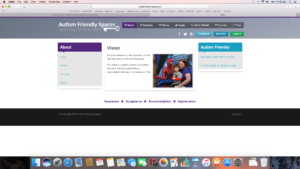http://autismfriendlyspaces.org
As I have mentioned in the past, I was part of a special organization called Autism Friendly Spaces. This organization specialized in helping certain organizations cater to people who are on the Autistic Spectrum. The tools at their disposal include task managers, rooms designated for quiet time, toys to help those who need something to fidget with in order to feel comfortable, and more. Back in 2013, I was approached by their director to become a volunteer within their organization. It was through this that I soon learned the benefits of being an insider helping this organization achieve its goals.
One of my first major tasks with Autism Friendly Spaces was to write a memorandum for the Metropolitan Museum of Art’s website and see how easily a person on the Spectrum could navigate the page. Of course, looking at the memorandum today, it’s obvious that I didn’t really follow any of the guidelines we learned in class for filing these particular reports. Even so, I was commended for my insight and my suggestions for the program, even though very few of them were taken to heart.
Now, due to my current schedule at work, I unfortunately have not been in contact with Autism Friendly Spaces for quite some time. As such, I’m not sure if I have set any sort of precedent for user testing tailored specifically towards people who struggle with Autism. However, going through this class and learning how these designs are rigorously put through all sorts of tests just to give people the smoothest experience possible, I would argue that this sort of specific testing should be implemented.
Consider this. There is a significant percentage of people that struggle with some sort of mental disability. They do not see the world the same way others do. This is something I can tell you from experience, being autistic myself. I commit to routines, I sometimes struggle with self-awareness and social cues, and there are times when I’m easily overwhelmed by various stimuli. However, not everyone on the spectrum can express these thoughts as articulately as I can (and that in itself is something I also struggle with, so that’s not saying much). If there were more instances where high-functioning autistic people could participate in user testing with the specific goal of making the experience more comfortable for people like them, that wouldn’t only change how we perceive autism in this country, but it may improve the user experience for everyone involved.
For as much as autistic people are described as different from neuro-typicals, there is still a lot that we have in common with the rest of the population. Not every autistic person sees the world in exactly the same way, just as not every person see the world in this way. But wouldn’t everyone benefit from a website that’s easier to navigate, or a schedule to organize what you’re doing and when? I feel like such things would be appealing to everyone, not just those on the spectrum. And while my proposal does specifically have autistic people in mind, I feel in the end that it would benefit everyone.
